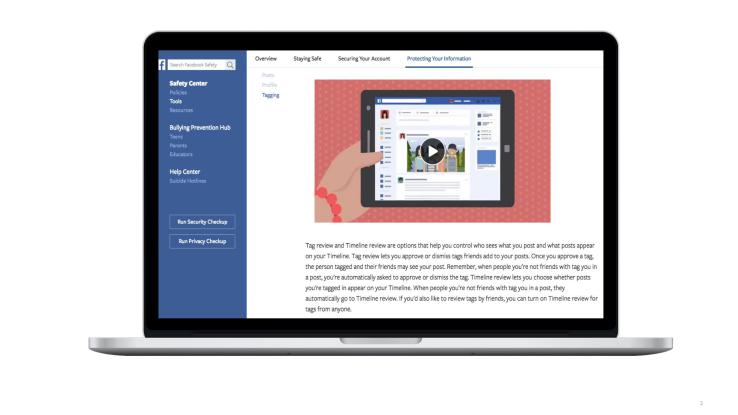

As Facebook, the social network with 1.7 billion users, has come under fire for how it has handled its editorial role as a “media” company, it is also trying to launch more ways for people to control their experience on the platform. Today the company unveiled a redesigned Safety Center, now localised into 50 languages, aimed at helping people set their privacy controls on Facebook’s social networking platform; and it has updated its Bullying Prevention Hub that Facebook says now has some 60 partners involved to make its tools more accessible.
Those partners include the likes of Childnet International, Connect Safely (an online forum for teens and their parents), and the Family Safety Online Institute.
The timing for this news is interesting for a couple of reasons. It comes one week after Facebook announced that it would be relaxing some of its content posting policies, essentially allowing for more graphic and potentially offensive posts on the platform, so long as they are deemed newsworthy.
And, the new Safety Center also comes a week after news broke that another big social network, Twitter, lost out on not one but two acquisition deals because of its inability to control trolls and harassment on its platform. Twitter, take note!
The Safety Center has been around since 2010 and the Bullying Hub since 2013. Both have seen periodic updates since then, sometimes in response to specific questions raised about online harassment. In the new versions, accessibility is the name of the game.
For starters, Facebook is making its tools more widely available for a global audience — an acknowledgement of the issue going beyond Facebook’s core audience of English speaking users.
Antigone Davis, head of global safety at Facebook, writes that the new version is now mobile-friendly — which makes sense, considering that in many countries mobile is the primary platform used to access the social network — and is now available in 50 different languages; along with more video to demonstrate how to use the controls that Facebook has on there.
The Bullying Prevention Hub, meanwhile, was first introduced in 2013 after Facebook developed the service with the Yale Center for Emotional Intelligence. The new version of the hub is not so much laden with more features, but its relaunch marks of how Facebook is working now with around 60 organizations to promote its existence and to use it more in cases where it is needed.
The fact that Facebook has been making it possible for people to beam their status updates to specific groups — even helping them to suggest how to form these in a practical way — to me really speaks of some of the shortcomings of Twitter in this regard. The question is whether it’s too late for Twitter to revamp something like this now.
Facebook is using the update to reiterate five areas where users should be aware of how they can control their experience:
- It suggests that everyone should turn on two-step verification for Facebook so that every time you log in from a new device, it verifies your identity through a code on your phone.
- It recommends reporting (using the link on every post) every time a post is offensive or abusive (but it doesn’t provide an update of how long or how those reports might be actioned).
- Facebook also suggests to create customized audiences to target your content better, either to friends, or colleagues at work, or regional audiences, or whatever you choose.
- Similarly, controlling tagging and customizing your timeline, Facebook says, will help you control your experience.
- Its privacy and security checkups take users through how to set all of the above up.

